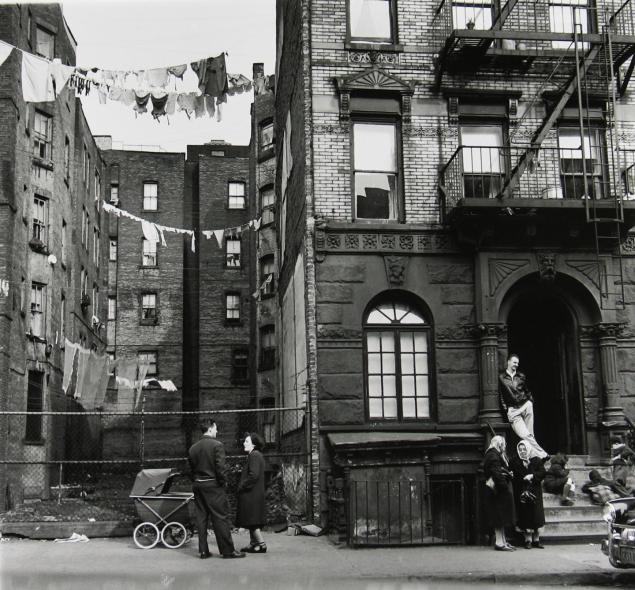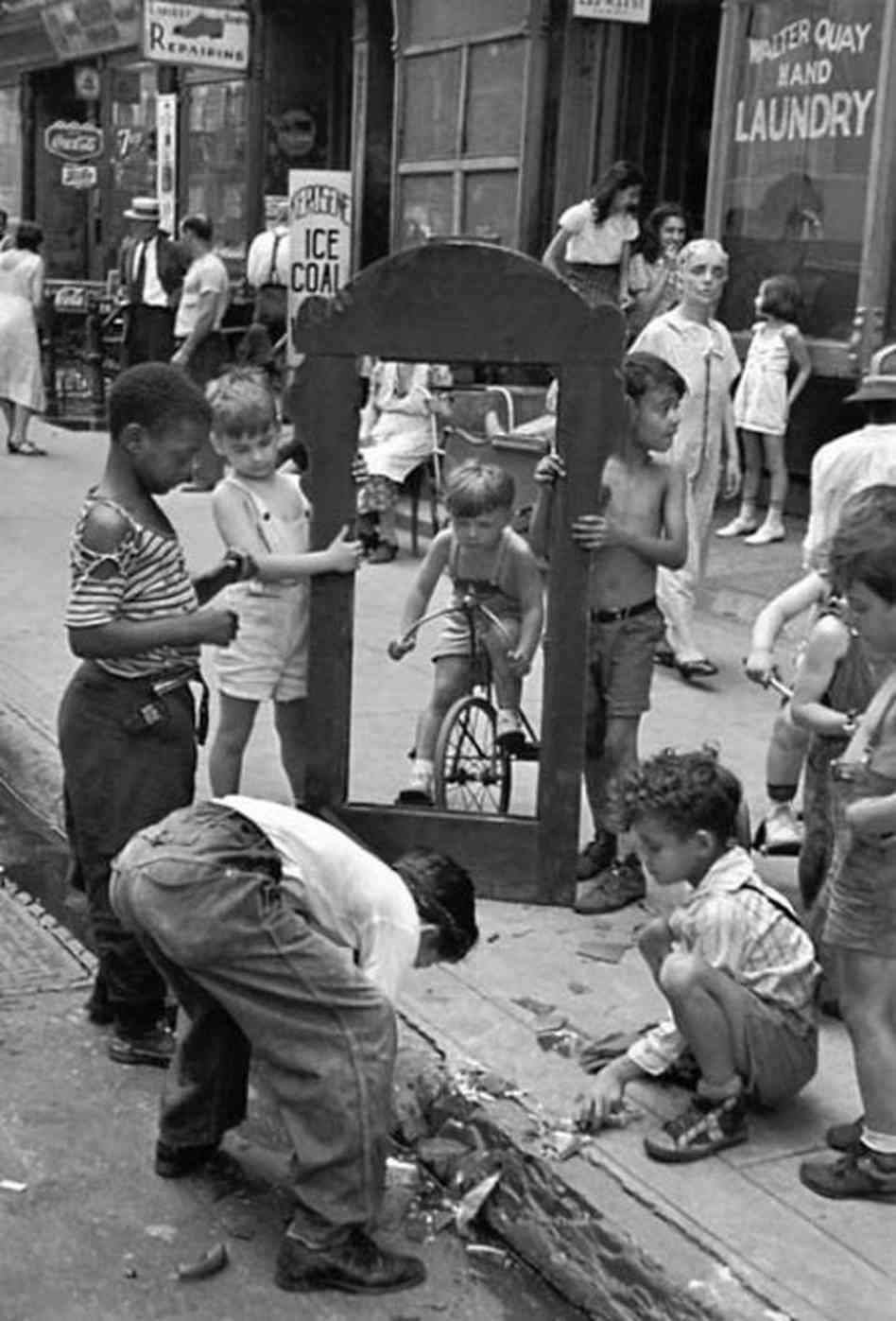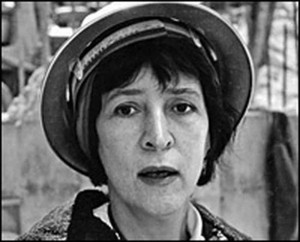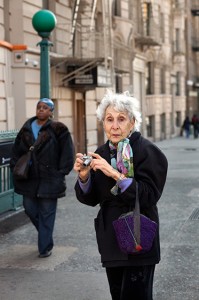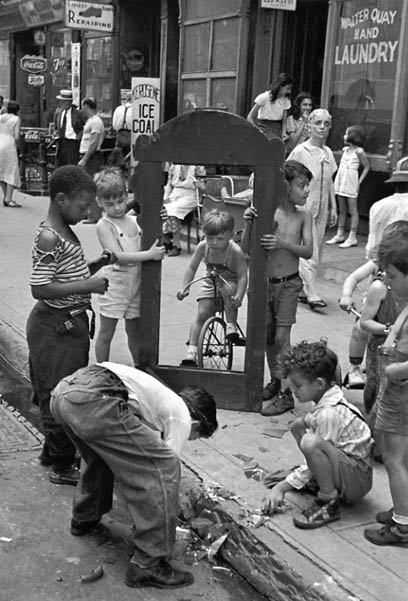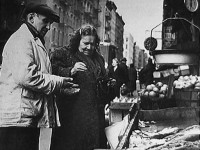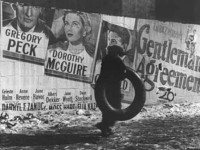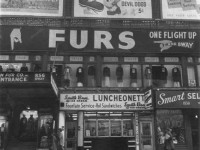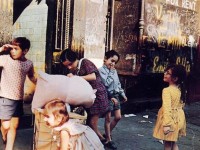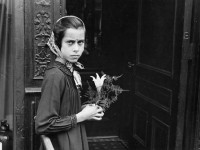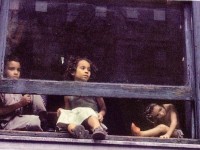Bringing Community Back into Focus
Compare Photo Icons Example: Text by Claire Roos, edited and adapted by Citizen Film.
It is often in the times of great suffering and hardship that the best ideas and creative movements are created. The Great Depression and World War II was one of those times, yielding the creation of a new photographic style of street photography called the New York School (also known as ‘Abstract Expressionism’). Made up almost entirely of New York Jews in the New York Photo League, this unique style of documentary photography varied greatly from the presiding style of federally commissioned photographs that conveyed overt social messages. Helen Levitt and Rebecca Lepkoff, two members of the New York Photo League, exemplified the New York School style in the their photography. Levitt’s Boys Playing on the Street photograph and Lepkoff’s Cherry Street are iconic in their representation of this innovative style of photography and in their ability to convey a personally significant connection with the viewer.
Rebecca Lepkoff and Helen Levitt grew up in similar circumstances. Both were Jewish women born to immigrant parents in New York during the second decade of the twentieth century. Both became dancers and neither originally intended photography to be their profession.
Levitt dropped out of high school to pursue art, teaching at the Federal Art Project program in East Harlem in 1937. After her subsequent job in a dark room, she became inspired by children’s chalk drawing in the city and set out to try photography herself. She found inspiration under her American teacher Walker Evans who had a direct approach to common subject and then later by her teacher Henri Cartier-Bresson, who had a way of gracefully capturing the flow of energy in a single moment. She led her subsequent years as a member of the Photo League, exploring street photography.
Lepkoff also originally started off as a dancer, and went on to take free classes with Arnold Eagle under the New Deal’s National Youth Administration. Always feeling a strong connection to the Lower East Side of New York, she studied under Sid Grossman to learn of the documentary style. Grossman’s emphasis on aesthetic photography with a social function and personal meaning provided a strong influence in Lepkoff’s photography.
The views and activities of the Photo League strongly influenced both of these women’s photography and helped them express their thoughts on society in a male-dominated world. The Photo League, later disestablished for its Communist connections, taught that photography could influence opinions on social change; it encouraged the documentation of the city in a way that went against stereotypes and allowed photographers to accurately portray the world in which they lived. Instead of the portrayal of the colossal city isolating individuals, the Photo League promoted eye-level depictions of the community and inter-personal interactions. These characteristics prove evident in the styles of both Lepkoff and Levitt.
Explore New York in the 1940’s on the interactive map below.
Helen Levitt’s picture, Boys Playing on the Street, is iconic in its expression of the New York School’s style and in Levitt’s personal ideals. This photograph is part of a series of uncaptioned photos of lower-class New Yorkers living out their summer days on the streets of the city. The picture focuses on the interactions between the boys, each intrigued by something another is doing. Their eyes lead to points of interest, while their hands are engaged in some kind of activity, whether it be holding a frame, riding a bike, or digging a hole. The surrounding urban life behind them acts as a frame to their play, just as a physical frame encases the boy on the bicycle. The racial barriers seem to be erased with the intermingling of white and black boys. Levitt dismantles the stereotype that the huge city belittles communities. She encapsulates multiple themes of community (children’s play, and curiosity, to name a few) and presents them to the viewer in an unbiased, thought-provoking way; in what way do the gestures, as shown through hands, reveal the human need to touch in order to connect with one another? What motivates the human need for community? In her visual representation of the city, Levitt’s photo allows the urban lifestyle to be shown in a whole new light.
Rebecca Lepkoff’s photo, Cherry Street, created in the 1940s, also shows the new innovative form of street photography with a personal touch. Although Lepkoff photographs her scene from farther away, a comfortable, relaxed, sense of community is still depicted. In a time around the war when patriotism was rampant and Jews felt confident in their identity, it is especially important that in Cherry Street, Lepkoff depicts her home, the Lower East side, in a much different way than the typical stereotypes of the time did: Although the poverty and shabbiness of the neighborhood is still present in the buildings in the background, the residents show domestic life in a dignified, American way. In the multiple interactions shown, the viewer can relate with the couple conversing with their new baby, a man casually leaning against a door frame, and mixed generations of people interacting below him. In this way, Lepkoff shows her own personal view of her home as a place that anyone could relate to. These people do not come across as foreigners living in piteous conditions, but rather as average citizens who live an honest, community-oriented life in the place they call home: the Lower East side.
Coming from immigrant Jewish families, both Lepkoff and Levitt set off to portray their world as they knew it: a place of converging cultures and communities, despite its social problems. They understood the value of social justice, expressed less overtly in their photos than their compatriots of the time. Both, growing up as dancers, focused on the importance of gestures between people that better illustrated the interactions and relationships between people. Whether it be through a conversation, or a subtle hand gesture, the viewer is left intrigued by its influence in the photo. And yet, Levitt seems to suggest an inquiry on the life and value of community in general urban situations, while Lepkoff makes more of a specific statement on the life in a certain geographic area in New York City. Either way, both photographers use their photos to focus on the connection of the emotion between their subjects and viewers to produce an iconic feeling of the social environment of the time and the value of the power of an outsider in the Photo League.
More images by Lepkoff and Levitt. Click to enlarge.
- Street Vendor
- Lower Manhattan, Gentleman’s Agreement
- 14th St. near Union Square
- NYC (Kids with Laundry) 1972
- NYC (Girl with Flower) 1939
- NYC (Kids in Window) 1959
Sources
Images
Lepkoff, Rebecca. Howard Greenberg Gallery, “14th St. near Union Square.” <http://www.rebeccalepkoff.com/2/14thSt.nr.UnionSquare.jpg>
Lepkoff, Rebecca. New York Daily News, “96-year-old photographer Rebecca Lepkoff brings the lower East Side back into focus” <http://www.nydailynews.com/photos/showbiz/96-year-old-photographer-rebecca-lepkoff-brings-east-side-back-focus-article-1.1039695>
Lepkoff, Rebecca. Howard Greenberg Gallery, “Gentleman’s Agreement.” <http://www.rebeccalepkoff.com/2/GentlemmensAgreement.jpg>
Lepkoff, Rebecca. Howard Greenberg Gallery, “Street Vendor.” <http://www.rebeccalepkoff.com/streetvendor.html>
Levitt, Helen. Laurence Miller Gallery, “Broken Mirror.” <http://www.laurencemillergallery.com/artist_levitt.html>
Levitt, Helen. Laurence Miller Gallery, “NYC (Girl with Flowers).” <http://www.laurencemillergallery.com/levitt_just_kids.html>
Levitt, Helen. Laurence Miller Gallery, “NYC (Kids in Window).” <http://www.laurencemillergallery.com/levitt_just_kids.html>
Levitt, Helen. Laurence Miller Gallery, “NYC (Kids with Laundry).” <http://www.laurencemillergallery.com/levitt_just_kids.html>
LeVine, Nancy. Rebecca Lepkoff’s portrait, “Untitled.” http://www.browneyesgallery.com/index.php#mi=undefined&pt=1&pi=10000&s=20&p=0&a=1&at=0
Links
Department of Photographs. The Metropolitan Museum of Art, “Henri Cartier-Bresson.” <http://www.metmuseum.org/toah/hd/cabr/hd_cabr.htm>
Department of Photographs. The Metropolitan Museum of Art, “Walker Evans.” <http://www.metmuseum.org/toah/hd/evan/hd_evan.htm>
History, “The Great Depression.” <http://www.history.com/topics/great-depression>
History, “World War II.” <http://www.history.com/topics/world-war-ii>
The Jewish Museum, “Sid Grossman.” <http://www.thejewishmuseum.org/onlinecollection/collection_results.php?artistlist=1&aid=6014>
Next New Deal – The Blog of the Roosevelt Institute, “National Youth Administration.” <http://www.nextnewdeal.net/national-youth-administration>
Paul, Stella. The Metropolitan Museum of Art, “Abstract Expressionism.” <http://www.metmuseum.org/toah/hd/abex/hd_abex.htm>
Pinson, Stephen. The New York Public Library, “NYPL, Where Do We Go from Here?” <http://web-static.nypl.org/exhibitions/league/introduction.html>
Reese, Kay and Leipzig, Mimi. American Society of Media Photographers, “Arnold Eagle.” <asmp.org/tutorials/arnold-eagle.html>
Map
Center for Urban Research. Welcome to 1940s New York. <http://www.1940snewyork.com/>















